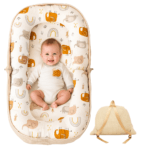Introducing solids to your baby is an exciting milestone, but it can also be challenging if your little one cries during meals. Understanding the reasons behind these tears is crucial for ensuring a positive feeding experience. Babies cry for various reasons when eating solids, ranging from teething pain to developmental readiness or even a dislike for specific textures and tastes. As a parent, it’s natural to feel concerned and eager to find solutions. This guide will explore the common causes of crying during mealtime and offer practical tips to help your baby transition smoothly to solid foods. By identifying and addressing the root of your baby’s distress, you can create a more enjoyable and stress-free environment for both of you.
Let’s delve into the possible reasons behind your baby’s mealtime tears and discover effective strategies to turn those cries into smiles.
Understanding why a baby cries during mealtime:

Understanding the reasons behind a baby’s crying during mealtime is crucial for several reasons:
- It ensures the baby’s physical comfort and health by identifying and addressing potential issues such as teething pain, allergies, or gastrointestinal discomfort. Recognizing the root causes of crying can prevent unnecessary stress for both the baby and the parents, promoting a more positive feeding experience.
- Understanding these reasons supports the baby’s developmental readiness and helps parents introduce solids appropriately, avoiding premature transitions that could lead to aversion or feeding difficulties.
- It aids in creating a nurturing and responsive feeding environment, fostering a positive association with mealtime, and encouraging healthy eating habits.
By being attentive to the baby’s cues and adjusting feeding practices accordingly, parents can effectively enhance their baby’s overall well-being and support their growth and development.
Common Reasons for Crying While Eating Solids?

- Details: As teeth erupt through the gums, babies experience significant discomfort and pain, making eating solids painful. The pressure of chewing can exacerbate the soreness, leading to crying during meals.
Discomfort or Pain
- Details: Digestive issues such as gas, constipation, or acid reflux can cause discomfort when eating. Babies might also cry if they have a sore throat or mouth sores, which makes swallowing solids painful.
Developmental Readiness
- Details: Some babies may not be developmentally ready to handle solids. Signs include pushing food out with their tongue or showing disinterest. Introducing solids too early can lead to frustration and tears.
Taste and Texture Sensitivities
- Details: Babies are new to different tastes and textures. They might cry in response to a flavor or texture they find unpleasant or unfamiliar. Some babies need more time to get used to solid foods.
Hunger or Fullness
- Details: Crying can occur if a baby is too hungry or already complete. If the baby is extremely hungry, it might be impatient and frustrated. Conversely, if it is full, it may cry to signal that it doesn’t want more food.
Eating Environment
- Details: A chaotic or stressful environment can make mealtime overwhelming for a baby. Loud noises, distractions, or an uncomfortable feeding position can contribute to crying.
Overstimulation or Fatigue
- Details: If a baby is overstimulated or tired, it may cry during meals. It’s essential to choose a calm and appropriate time for feeding that aligns with the baby’s natural routine.
Is it normal to Cry baby While Eating Solids?
Yes, it’s relatively common for babies to cry while eating solids, especially when they are first introduced to new foods or textures. Several factors can contribute to this behavior, including teething pain, discomfort from new textures, developmental readiness, or even frustration. Babies may also cry if they are not hungry or feeling overwhelmed. While occasional crying is normal, if it persists or is accompanied by other concerning symptoms, it’s a good idea to consult a pediatrician to ensure no underlying issues affect your baby’s eating experience.
Read to know more: How Long Does Homemade Baby Food Last? Essential Storage Tips
How do I Recognize teething Pain?

Recognizing teething pain in your baby involves observing several vital signs and symptoms. Here are some common indicators:
- Increased Drooling: Excessive drooling is often one of the first signs of teething.
- Chewing and Gnawing: Babies chew on toys, fingers, or other objects to relieve gum discomfort.
- Irritability and Fussiness: Teething can make babies more irritable and prone to crying.
- Swollen or Tender Gums: You might notice your baby’s gums are swollen, red, or tender to the touch.
- Changes in Eating Habits: Babies may refuse to eat or have difficulty swallowing due to gum pain
- Sleep Disturbances: Teething discomfort can disrupt your baby’s sleep patterns.
- Rubbing Ears or Cheeks: Babies may rub their ears or cheeks to soothe referred pain from the gums.
- Mild Fever: A slight increase in body temperature can occur, though high fever is not typically associated with teething.
What foods are best for teething?
When your baby is teething, offering certain foods can help soothe their gums and provide relief. Here are some of the best foods for teething babies:
- Cold Foods:
- Chilled Fruits and Vegetables: Slices of chilled cucumber, apple, or carrot can be soothing.
- Frozen Fruit: To prevent choking, small pieces of frozen banana, mango, or berry can be placed in a mesh feeder.
- Teething Biscuits and Rusks:
- Hard, unsweetened teething biscuits or rusks can be chewed on to relieve gum discomfort.
- Soft Foods:
- Yogurt: Cold, plain yogurt can be soothing and easy to eat.
- Purees: Chilled fruit and vegetable purees can be gentle on sore gums.
- Cold Washcloth:
- While not food, a cold, damp washcloth can be given for the baby to chew on for relief.
- Breast Milk Popsicles:
- You can freeze breast milk in popsicle molds for a soothing treat if breastfeeding.
- Cold Cheese Sticks:
- Chilled cheese sticks or small pieces of cold cheese can provide both nutrition and comfort.
How do I introduce new foods?
Introducing new foods to your baby can be a gradual and enjoyable process. Here’s how to do it effectively:
- Start Slowly:
- Begin with single-ingredient foods to identify any potential allergies or sensitivities. Offer one new food at a time and wait 3-5 days before introducing another.
- Observe Reactions:
- Monitor your baby’s reactions to new foods. Look for signs of allergies or intolerances, such as rashes, swelling, or gastrointestinal issues.
- Mix with Familiar Foods:
- Combine new foods with familiar ones to make the transition smoother. For example, mix a new vegetable with a favorite fruit puree.
- Offer in Small Amounts:
- Serve small portions of new foods to start with. This helps your baby get used to the taste and texture without being overwhelmed.
- Use Different Textures:
- Experiment with various textures, from purees to soft, mashed foods. Gradually introduce more textured foods as your baby becomes comfortable.
- Be Patient and Persistent:
- It may take several tries before your baby accepts a new food. Keep offering it without pressure, as repeated exposure can increase acceptance.
- Make Mealtime Fun:
- Use colorful utensils and create a positive mealtime atmosphere. Engaging your baby with playful interactions can make trying new foods more enjoyable.
- Follow Your Baby’s Cues:
- Pay attention to your baby’s hunger and fullness cues. Respect their preferences and avoid forcing them to eat.
- Maintain a Balanced Diet:
- Ensure that new foods are part of a balanced diet, offering a variety of fruits, vegetables, grains, and proteins to provide essential nutrients.
What Should I Do If My Baby Refuses to Eat Solids When Teething?

When your baby refuses to eat solids during teething, it’s essential to approach the situation with patience and understanding. Here are some strategies to help:
- Offer Comforting Foods:
- Provide chilled or cold foods, such as yogurt, applesauce, or pureed fruits and vegetables, that can soothe sore gums.
- Teething biscuits or cold teething rings can also be helpful.
- Be Flexible with Feeding Times:
- If your baby is particularly fussy at mealtimes, try offering solids at different times when they might be more comfortable.
- Avoid forcing your baby to eat if they’re not interested.
- Maintain a Calm Environment:
- Create a soothing and calm atmosphere during meals. Reduce distractions and ensure your baby is in a comfortable position.
- Keep Breastfeeding or Formula Feeding:
- Continue to offer breast milk or formula, which provides essential nutrients. These can serve as a primary source of nutrition until your baby is more comfortable eating solids again.
- Offer Soft and Gentle Foods:
- Choose soft, easy-to-eat foods that require minimal chewing, like mashed potatoes, avocado, or finely pureed vegetables.
- Be Patient and Consistent:
- Understand that teething can be a painful and uncomfortable time for your baby. Be patient and keep offering solids without pressure.
- Use Distraction Techniques:
- Sometimes, gentle distractions like a favorite toy or soothing music can help your baby feel more at ease and willing to eat.
- Provide Teething Relief Before Meals:
- Offer a teething ring or gently massage your baby’s gums before mealtime to reduce discomfort.
- Experiment with Different Temperatures:
- Some babies prefer warm foods, while others find cold foods more soothing. Experiment to see what your baby prefers.
- Consult a Pediatrician:
- If your baby consistently refuses to eat solids and you’re concerned about their nutrition or growth, consult a pediatrician for personalized advice and support.
Tips for Helping Your Baby Enjoy Mealtime
Creating a Routine
- Details: Establish a consistent feeding schedule to create a sense of predictability and security. Regular mealtimes help your baby know what to expect, reducing anxiety and resistance to eating.
Offering Comfort and Reassurance
- Details: Be patient and provide gentle reassurance if your baby cries during meals. Hold them close, speak softly, and make eye contact to help them feel secure. Sometimes, a comforting touch or a brief break can calm them down.
Trying Different Foods and Textures
- Details: Gradually introduce various foods and textures to help your baby adapt to new tastes. Offer small, manageable pieces and observe their reactions. If they dislike something, try again later or in a different form.
Observing and Responding to Cues
- Details: Pay attention to your baby’s hunger and satiety cues. If they turn away, push food away, or close their mouth, they might be complete or not ready to eat. Respect their signals and avoid forcing food.
Creating a Positive Eating Environment
- Details: Ensure mealtimes are calm and free from distractions. Turn off the TV, put away toys, and create a pleasant atmosphere. A high chair that supports good posture and a comfortable setting can make a big difference.
Offering Cold or Teething-Friendly Foods
- Details: If teething is the issue, offer chilled fruits, vegetables, or teething biscuits to soothe their gums. These can provide relief and make eating more comfortable.
Making Mealtime Fun
- Details: Engage your baby with playful interactions during meals. Use colorful utensils, make funny faces, or sing songs to create a joyful atmosphere. Positive reinforcement can help build a positive association with eating.
Introducing Solids Gradually
- Details: Start with small amounts of food and gradually increase as your baby gets used to solids. Mix new foods with familiar ones to ease the transition and reduce resistance.
Maintaining a Relaxed Approach
- Details: Stay relaxed and avoid showing frustration if your baby cries or refuses food. Babies can pick up on your emotions, so maintaining a calm demeanor can help them feel more at ease.
Seeking Professional Advice
- Details: If your baby consistently cries during meals and you cannot identify the cause, consult a pediatrician or feeding specialist. They can offer guidance and help rule out any underlying medical issues.
FAQ
How can I tell if my baby is ready for solids?
- A: Signs of readiness include sitting up with minimal support, showing interest in food, and losing the tongue-thrust reflex that pushes food out of the mouth.
What are some good first foods for my baby?
- A: Start with single-ingredient, soft foods like mashed bananas, avocado, sweet potato, or baby cereal. Gradually introduce other fruits, vegetables, and proteins.
How can I make mealtime less stressful for my baby?
- A: Create a calm, distraction-free environment. Establish a consistent routine, offer comfort and reassurance, and make mealtime fun with playful interactions.
What should I do if my baby chokes on food?
- A: Stay calm and follow first aid guidelines for infant choking. If your baby continues to struggle, seek immediate medical attention. Always supervise meals and offer appropriately sized food pieces.
How can I soothe my teething baby during mealtime?
- A: Offer chilled or teething-friendly foods like cold fruits, vegetables, or teething biscuits. Gentle gum massages and teething rings can also provide relief.
What if my baby has food allergies or intolerances?
- A: Introduce new foods one at a time and monitor for any allergic reactions, such as rashes, swelling, or difficulty breathing. Consult with a pediatrician if you suspect an allergy.
How often should I feed my baby solids?
- A: Start with one meal per day and gradually increase to two to three meals as your baby gets older and more accustomed to solids. Follow your baby’s hunger cues and adjust accordingly.
How can I encourage my baby to try new foods?
- A: Offer new foods alongside familiar favorites. Be patient and keep offering the new food without pressure. Sometimes, it takes multiple exposures for a baby to accept a new taste.
Q: When should I seek professional help for feeding issues?
- A: If your baby consistently cries during meals, refuses to eat, shows signs of severe allergies, or if you have any concerns about their nutrition or development, consult a pediatrician or feeding specialist for guidance.
Conclusion
Understanding and addressing why your baby refuses to eat solids during teething is key to easing their discomfort. By offering soothing, soft foods, maintaining a calm feeding environment, and being patient, you can help your baby navigate this challenging period. Remember, it’s normal for teething to affect eating habits, so continue to provide comfort and adjust as needed. If concerns persist, don’t hesitate to consult a pediatrician to ensure your baby’s health and nutritional needs are met.















